Arts
Brown Time at The Movies
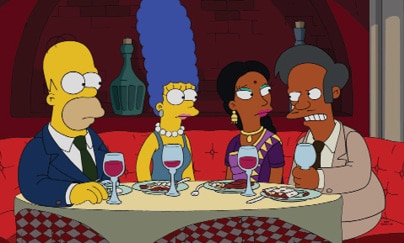
Earlier this year, Sakhi, a New York City based nonprofit for South Asian women, organized a special screening of the documentary, The Problem with Apu, to a packed audience. The documentary written and starring Indian American Hari Kondabolu, was followed by a panel discussion on the negative stereotypes that the show may have attributed to South Asians.
The discussion underscored that for the vast majority of South Asians growing up in America in the 1990s, Apu Nahasapeemapetilon from The Simpsons was the only misrepresented idea of their identity on television. Like a Lubber line, Apu with his weird accent and mannerisms etched forever in the Western mind an Indian identity that perhaps never existed.
The tides may be changing, not only with the rise of South Asians in American entertainment, but also given the new-found affinity toward their identity amongst the millennial immigrants. Since performing arts are often one of the most visible barometers reflecting socio-cultural changes, the American film and television industry today captures the story of an interesting immigrant crossover.
Priyanka Chopra is becoming as ubiquitous in Hollywood as lungi in India. Aziz Ansari became the first Asian American to win a Golden Globe for acting in television. Never mind the sexual misconduct charges leveled against the actor soon after, Ansari now also inspires discussions on misogyny and misplaced feminism in mainstream American pop culture — perhaps another first for a South Asian actor.
In Hollywood, The Big Sick, a sensitive autobiographical romantic-comedy depicting the eccentricities of an immigrant Pakistani family, secured a best screenplay Oscar nomination for Kumail Nanjiani and Emily V Gordon. Earlier in January, at the Sundance Film Festival, Priyanka Chopra’s A Kid like Jake and Irrfan Khan’s Puzzle, made their world premiers to rave reviews.
On American television, the blink-and-you-miss-it South Asian appearances have been replaced by some serious brown performances. The year started with trailers of Alex, Inc. a new comedy series on ABC, starring Zach Braff, where Tiya Sircar of Internship fame, plays his wife Arunima ‘Rooni’ Schuman. Those missing Mindy (Kaling) on TV, can find solace as the actress released the first trailer for her new show Champions, in early February. Besides Kaling, the show also stars another Indian American Mouzam Makkar as Britney.
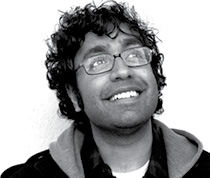
Hari Kondabolu’s The Problem With Apu is a searing critique of the show’s negative sterotypes.
If you too think that brown brawny men are the stuff of new American fantasies, then there is good news in the form of Heroes alum Sendhil Ramamurthy making a comeback as Paul Hammond in Reverie on NBC this spring. Aparna Brielle in A.P. Bio on NBC, Rizwan Manji and Arjun Gupta in The Magicians on SyFy, Rahul Kohli in iZombie on CW TV are some of the other South Asian actors making their presence felt. The third season of The Good Place, which aired earlier this year, showed both Jameela Jamil and Tiya Sircar in memorable performances. In addition, many new shows may be breaking new grounds by diminishing prejudices and normalizing the presence of Muslims, browns or immigrants in America. Season 2 of Designated Survivor on ABC, which began airing in January, showed Kal Penn, playing Seth Wright, looking convincing as press secretary.
With so much brown visibility in popular culture, especially at a time when ugly race and color rhetoric has been resonating in the background, could it be safe to say, sardonically perhaps, that it may be a good time to be a brown in American entertainment today?
Kabita Chakraborty, assistant professor, York University, Canada, who authored, Young Muslim Women in India: Bollywood, Identity and Changing Youth Culture, says: “We are in a very interesting time in American entertainment now. We are seeing public demand for more diversity on screens. Particularly in urban centers, audiences are saying we want to view shows, movies and see images that reflect my workplace.”
“However, this is not to say that diversity is happily accepted; the online pushback around Kelly Marie Tran’s character in The Last Jedi is testament to that,” warns Chakraborty. She was referring to online trolls who launched a racist vitriol late last year against Vietnamese-American, Marie-Tran, the first Asian American to play a part in Star Wars.
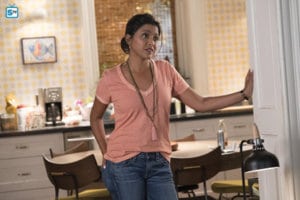
Tiya Sircar plays Zach Braff’s wife as Arunima ‘Rooni’ Schuman of Alex, Inc. a new comedy series on ABC.Indian
Despite the resistance, many new series are showing South Asians in important positions, as they are in real American life today. Perhaps that explains why, it may be important to see, say an Indian American actor such as Manish Dayal playing Devon Prakash, a skilled, upright doctor in the new series, The Resident, which premiered on Fox earlier this year. India today provides the largest number of international medical graduates to the United States and Indians and Indian Americans constitute the largest non-Caucasian segment of American physicians, accounting for 5 percent of the physician population in the country. For many Americans in metropolitan cities, it is not unusual to encounter an Indian doctor in a medical facility. This reel depicting real scenario is very different from the South Asian caricature represented earlier in which Indians were 7-Eleven owners and all Pakistanis appeared as taxi drivers. By contrast, the current South Asian portrayal are less demeaning and the roles they play are also far more substantial.
POLITICAL IRONY?
In a convoluted way, the current political fusillades that lampoon the minority, may have worked towards creating an elevated platform for them. Danish Renzu, a Kashmir born, Los Angeles based filmmaker, who is preparing to take his second feature film, The Illegal, to Cannes, says: “Trump ironically humanized the immigrants. The vitriol snowballed into a situation where the filmmakers wanted to focus on these topics and everyone wanted to know about immigrant back stories.”
“Right now,” he laughs, “It’s a privilege to be a brown in Hollywood.”
Several Hollywood South Asian veterans concur. Noel De Souza, one of the earliest Indian actors to bag a role in Hollywood in the 1950s, who has appeared in The Wedding Crashers and Star Trek Voyager, acknowledges there is a push for diversity presently, but he stops short from calling it a good time for browns: “It may be a good time for Indians, but not all browns as, if you see, the Latinos have been completely left out.”
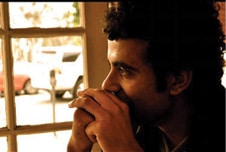
Danish Renzu “Right now, it’s a privilege to be a brown in Hollywood.”
De Souza, who has spent more than five decades in Hollywood, began at a time when he had to hide his Indian identity and pose either as Venezuelan or Brazilian to bag roles, says that Hollywood also works on the perceptions that shape the world: “Back in the 50s and 60s, Latin Americans were prominently seen in Hollywood. They had a lot of stuff to do because back then, Latin America was conceived as a romantic notion. But suddenly the perception changed and they became gardeners and house maids in Hollywood.” De Souza says that Indians right now are being viewed as this neo-rich, educated, flourishing community and the effect is reflected on the screen, “Whether they have reached their pinnacle or if they will last, can’t be said.”
Another shift is that it’s not just the minorities who want their voices heard. Nisha Ganatra, film producer and director of Chutney Popcorn and Cosmopolitan says: “I think it has always been important to tell stories about other cultures, but that only people from other cultures have felt urgent about it for many decades now. I do feel a shift in Hollywood, where the powers that be are finally interested in cultures outside of what has been presented as mainstream for so long and I do feel that there is room for more stories now more than ever before.”
STILL NOT PROTAGONISTS
When Priyanka Chopra became the first Indian actor to secure a lead role in an American sitcom, it was momentous. But her name is Alex Parish, hardly reflecting her Indian connection. It was only later that one discovered that Parish has Indian heritage too. But interestingly, the character may have worked as a cue for others. In A.P. Bio, Aparna Brielle’s character is introduced as Sarika Sarkar, named after Indian philosopher Prabhat Sarkar, cutting off any ambiguity at the onset.
Many Asian American actors admit that despite an increased window of opportunity, the road is still arduous. Mouzam Makkar, actor and producer, who is seen in the Exorcist, The Vampire Diaries and Law & Order, says: “I’ve been lucky to have had the opportunity to play a lot of different characters with a majority of them not being written specifically for a South Asian woman. Having said that, it’s still been a difficult journey. Leads of most TV shows are Caucasian. I don’t usually get to audition for lead roles, it’s mostly for supporting characters, like the best friend, the neighbor, or the co-worker. Which means, the story I’m in isn’t about my character; my character is merely a device to serve the lead’s storyline. That can be frustrating.”
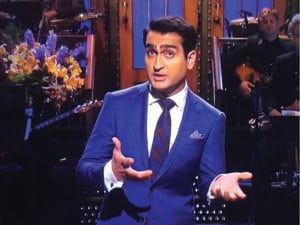
Kunail Maniana on NBC’s Saturday Night Live.
So, while diversity may have arrived in entertainment, moving up the food chain has yet to follow. Chakraborty says: “The culture makers in Hollywood are still very much male and white, and continue to shape ‘what’ diversity looks like. These power brokers are quick to use a tired rhetoric of economics to justify their decisions around diversity. While there are certainly many more South Asian faces in popular culture, it is going to take more time to expand the complexity of these characters, and a lot more time for these characters to be the main protagonists of their own story-line.”
Many in Hollywood are surprised that this didn’t happen sooner. Actor Shannon Brown, who has performed in Empire, Training Day and Every 21 Seconds, says: “Hollywood overall, is an extremely difficult business to break through in regardless of skin tone, but in the past it was even more challenging for people of color. I believe a big reason was that studio heads, show runners, etc. went with safe, albeit outdated, proven business models that they knew would provide a solid ROI (return on investment). For multiple reasons, I believe many were scared to take that risk of going outside of the box. Thankfully, I believe that trend is changing as we see more and more people of color breaking through in powerful, substantial roles as opposed to the stereotypical roles we’ve seen in the past and it has been very successful.”
DELAYED AWAKENING
Though it took long, those who have been promoting South Asian talent can feel the change in perception. Christina Marouda founder, Indian Film Festival of Los Angeles says: “It is certainly easier to promote South Asian talent today compared to a decade or two ago. The South Asian actors today compared those decades ago have it easy. There is a plethora of them appearing everywhere. TV has changed the game and people such as Mindy Kaling, Aziz Ansari and Nisha Ganatra are all working in the industry and are creating their own content, which means that even though some of the roles South Asian talent has access to may still be to some extend stereotypical, they now have access to South Asian writers/directors who work in the industry and who can create engaging roles for them. On top of that, you have executives like Bela Bajaria (president of NBCUniversal studio) who put South Asian talent on the map.”

Rahul Kohli in iZombie
Makkar says that South Asians are finally being seen as leads and even creators of their stories and that is an important change. Giving the example of her role in Champions, she says: “I play Britney Sundaram — an Instagram influencer/yoga instructor. Britney is opinionated, fashionably bold and has a flair for the dramatic — a characterization that you don’t often see being played by South Asian women.”
With more writers and directors of Indian descent taking prominent roles in entertainment, the performers will also grow, says De Souza. Some have argued that one of the reasons it took longer is because some of the biggest Bollywood stars settled for bit roles in Hollywood. From Aishwarya Rai to Amitabh Bachchan, the role repertoire scarcely matched their star status. However, Danish Renzu defends their efforts: “Aishwarya could be credited to putting India on the global map with her repeat appearances at the Cannes. Also, let’s not forget that some of the biggest Bollywood stars do not want to cross over. They are happily doing what they are doing back home.”
The times have changed, De Souza says. It is a long way from the time he was looking for roles in the 1950s and 1960s, when the only place for an Indian in Hollywood was for a jungle scene.
